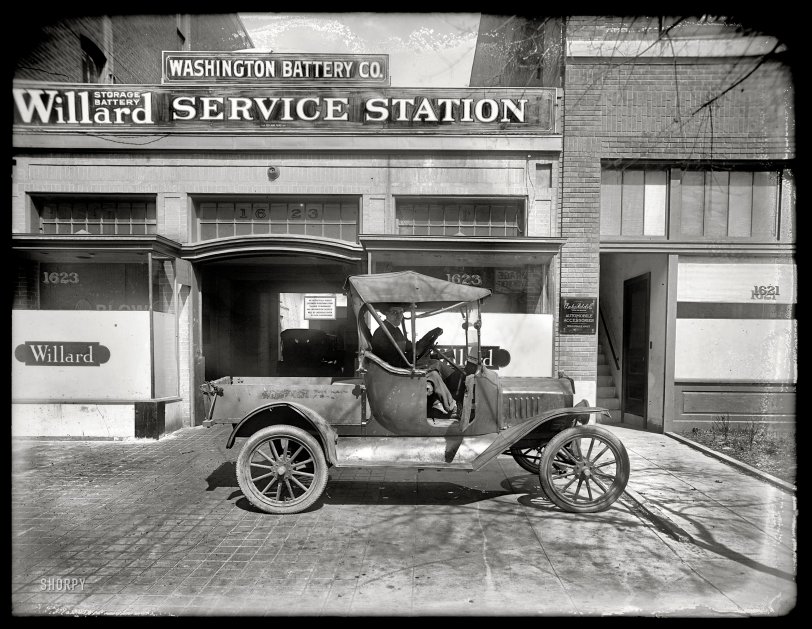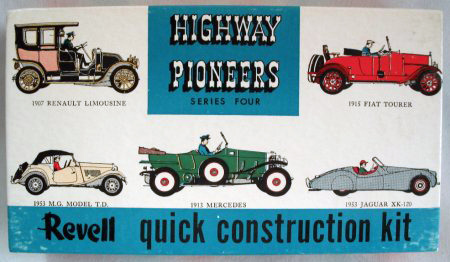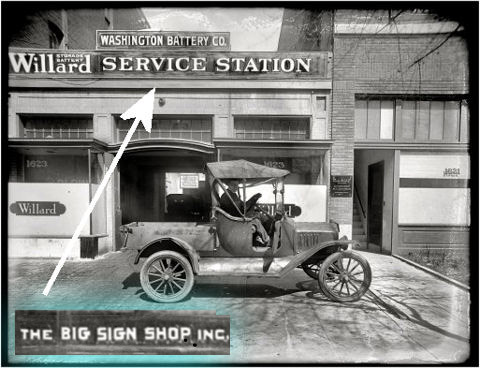


Framed or unframed, desk size to sofa size, printed by us in Arizona and Alabama since 2007. Explore now.
Shorpy is funded by you. Patreon contributors get an ad-free experience.
Learn more.

- Baldwin 62303
- Baldwin VO-1000
- Cold
- No expense spared
- Tough Guys
- Lost in Toyland
- And without gloves
- If I were a blindfolded time traveler
- Smoke Consumer Also Cooks
- Oh that stove!
- Possibly still there?
- What?!?
- $100 Reward
- Freeze Frame
- Texas Flyer wanted
- Just a Year Too Soon
- WWII -- Replacing men with women at the railroad crossing.
- Yes, Icing
- You kids drive me nuts!
- NOT An Easy Job
- I wonder
- Just add window boxes
- Icing Platform?
- Indiana Harbor Belt abides
- Freezing haze
- Corrections (for those who care)
- C&NW at Nelson
- Fallen Flags
- A dangerous job made worse
- Water Stop
Print Emporium
Hop In: 1919

Washington, D.C., circa 1919. "Washington Battery Co., L Street." We saw the garage earlier in this post. National Photo Co. glass negative. View full size.
Highway Pioneers
My first modeling experience was building some of the styrene Highway Pioneers models made by Revell. I built a bunch of them and had a lot of fun in the process. They were not terribly durable, at least in my young hands, but I loved them nevertheless. The distinctive feature that I remember, like OTY describes, was the way the wheels were attached. You were supposed to heat a slot screwdriver tip over a flame, and use it to melt the end of the axle. This formed a tip at the end like a nailhead that kept the wheel on. It was clever, by you had to be careful not to melt the axle into the wheel. No two hubs ever looked quite the same, but it worked.

Buying a car?
This reminds me of the last time a dealer sold me a car. He insisted that the car he was selling me is a demo and nothing was wrong with it. After having problems with the car he sold me I went to his workmen and asked them for a computer printout and sure enough the car was in a major accident! "We Respectfully request costumers to refrain from talking to workmen any information desired will be cheerfully given by floor superintendent."
[That Bob Mackie was kind of a blabbermouth. - Dave]
Such a spindly little thing
It's the scrawny 98 pound weakling of pickup trucks, compared to the 2-ton behemoths of today.
Brought to mind
This vehicle reminded me of the plastic model car kits my brother and I used to put together in the late forties, very early fifties during long summer days with no school. They were usually (very) antique old-time cars which we could not conceive of being road-worthy, which we had never seen and which we usually messed up due to the plastic cement which dissolved the plastic and the enamel paint which was difficult to apply neatly. Also each and every little part had to be attached, sometimes with a heated metal object to secure wheels, spokes, etc. The kits were sold in dime stores for a dollar or less. Just for the halibut, I decided a minute ago to look them up on the interweb. There are no more $1 car models, more like $20 and up, and the ones we had are long gone. I first heard about Stanley Steamers and Model T Fords via those plastic do-it-yourself car models. Remember plastic bubbles and magic growing rocks? All kinds of cheap crap to keep the kids busy in the summer. Good times.
Pick Em Up Truck
I can't get past the sign with the words "any information desired will be cheerfully given". As if you would expect to get info delivered in a grouchy manner.
The BIG SIGN SHOP, Inc.
On my best day I couldn't photograph something like this and get the clarity that it shown in this photo.
Hard Four Years Cranking
Super is offering a lift in his 1915 Ford Model T Runabout. No starter motors on this model. He hand cranks it and then gets in.
Rear deck and bulb type horn have been replaced with aftermarket pickup bed and manual horn. Practical pickup style not offered by Ford until 1925.
Big Sign Shop
Zooming in we see the name of the business that made the sign. Like it.

Pick Me Up
Is this the ancestor of all pickup trucks?
Also: note the sign. No talking to the mechanics.
Before the Insurance Excuse
They asked politely that you not talk to the guy who's actually working on your car.
























On Shorpy:
Today’s Top 5